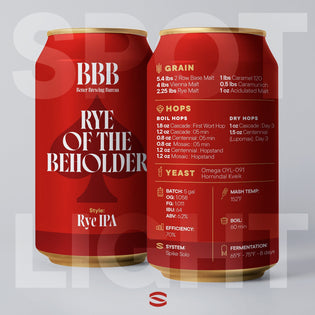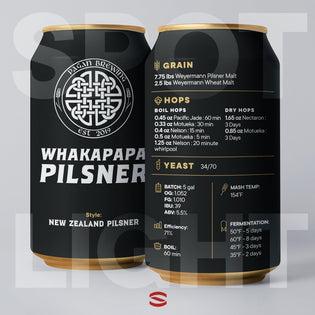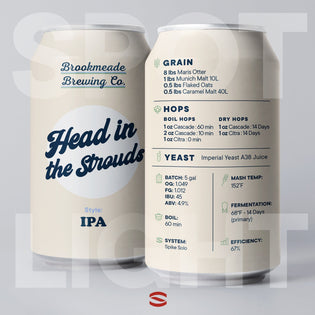
The Brewers: Annapolis Homebrew Club
The Annapolis Homebrew Club is a group of like minded individuals with various backgrounds, from various locations across Maryland.

While the club is primarily based in Annapolis, our members span across the entirety of Anne Arundel County and beyond.

With a passion for brewing (and drinking), our members help promote the public awareness and appreciation of the quality and variety of homebrewed beer through education, research, and the collection and dissemination of information.
The Beer: Pale Ale
Every year our club hosts a charity event called Pints 4 Paws, located in Annapolis, MD.
The event has more than 50 homebrew beers, 6 local breweries and multiple vendors/food trucks devoted to creating an amazing beer festival dedicated to supporting our 4 legged friends.
All money raised supports the Anne Arundel Society for the Prevention of Cruelty of Animals (AASPCA).

This recipe was developed by the club with the event's theme in mind, hence the name, Man's Best Friend. This is a very drinkable Summer beer, with a crisp citrus twist—great for those warm days!

The Recipe: Man's Best Friend

INGREDIENTS
GRAIN
- 20 lbs & 12 oz 2 Row Base Malt
- 2 lbs & 4.9 oz Munich
- 1 lbs & 2.4 oz Crystal 20
- 9.2 oz Vienna
HOPS
- Boil hops: 1.5 oz Cascade - 60 min
- Boil hops: 1 oz Amarillo - 15 min
- Boil hops: 1 oz Citra - 5 min
- Whirlpool at 170ºF : 2 oz Amarillo
- Whirlpool at 170ºF : 2 oz Cascade
ADJUNCT
- 6oz Sweet orange peel: Immediately at flameout. Use hop spider then remove once the temp gets to 170ºF, then add whirlpool hops
YEAST
- American Ale- Jasper (or any American Ale yeast)

INSTRUCTIONS
BATCH SIZE: 11 gal
OG: 1.052
FG: 1.012
IBU: 39.9
ABV: 5.3%
EFFICIENCY: 63.6%
MASH TEMP: 152ºF
BOIL: 60 min
FERMENTATION: 68ºF - 7 days
SYSTEM: Spike Solo 20 gal
Cheers,
Scott & Annapolis Homebrew Club
Spike Summarizes: All About Pale Ales
What is a Pale Ale?
A Pale Ale is a beer style characterized by its hop-forward nature and balanced malt profile. It typically features a golden to amber color and offers a range of hop flavors and aromas.
Pale Ales bridge the gap between light and dark beers, offering a versatile and approachable option for beer enthusiasts. They retain the hop flavors and aromas while providing a balanced and refreshing drinking experience.
Appearance
Pale Ales usually have a clear appearance, ranging from golden to amber hues. This clarity comes from traditional brewing techniques and the use of specific grains and hops.
What distinguishes Pale Ale from other beers?
Pale Ales have unique characteristics that set them apart from other beer styles, including traditional lagers and IPAs.
Flavor Profile
Pale Ales offer a balanced and hop-forward flavor profile. They showcase floral, earthy, and sometimes citrusy hop flavors. The hop bitterness is moderate, allowing the malt character to provide a balanced and refreshing drinking experience.
Aromatic Intensity
Pale Ales are known for their inviting hop aroma. They exhibit bright and balanced aromas of hops, with floral and citrus notes being common. The aromatic bouquet of these beers can be enticing and enjoyable.
What's the history of Pale Ale?
Pale Ales have a long and storied history, originating in England in the 18th century. The style emerged as brewers began to use pale malts, which produced a lighter-colored beer compared to the darker ales of the time.
Pale Ales gained popularity due to their balanced flavor profile and refreshing nature. Over time, the style evolved, with variations like the American Pale Ale emerging, showcasing more pronounced hop flavors and aromas.
What does a Hazy Pale Ale taste like?
Pale Ales offer a flavorful and balanced experience that combines hop-forward characteristics with a clean and refreshing profile.
Hop Flavor and Aroma
Pale Ales showcase a range of hop flavors and aromas. Floral, earthy, and citrus notes are commonly present, providing a balanced and enjoyable hop character.
Balanced Bitterness
While hop bitterness is present in Pale Ales, it is typically moderate compared to IPAs. The focus is on hop flavor and aroma rather than intense bitterness, resulting in a smooth and balanced drinking experience.
Malt Backbone
Pale Ales have a balanced malt backbone that provides subtle sweetness and depth to the overall flavor profile. The malt character complements the hop flavors, creating a well-rounded beer.
How is Hazy Pale Ale made?
The brewing process for Pale Ales involves specific techniques to achieve the desired clarity, hop flavors, and balanced profile.
Grain Bill
Pale Ales typically include pale malt as the base, with occasional additions of specialty malts for complexity. The grains contribute to the beer's color, flavor, and mouthfeel.
Hop Selection
A variety of hops can be used in Pale Ales, depending on the brewer's preference. Hops with floral, earthy, and citrus characteristics are common choices to enhance the balanced and aromatic qualities of the beer.
Hopping Techniques
Pale Ales often employ multiple hop additions during the brewing process. Early additions provide bitterness, while late additions contribute to hop flavors and aromas. Some brewers use dry hopping to further enhance the hop character.
Yeast Strains
Yeast strains used in Pale Ales are often chosen for their ability to produce clean and balanced flavors. Certain yeast strains may also contribute subtle fruity esters that complement the hop and malt profile.
Water Chemistry
Water chemistry plays a significant role in brewing Pale Ales. Adjustments can be made to the water profile to enhance hop flavors and achieve the desired balance. Some brewers aim for a balanced profile that allows the hop and malt characteristics to shine.
How strong is a typical Pale Ale?
Pale Ales generally have a moderate alcohol by volume (ABV) ranging from 4% to 6%.
The moderate alcohol content of Pale Ales makes them highly sessionable, meaning you can enjoy multiple servings without becoming overwhelmed by their potency. This makes them a great choice for longer social gatherings or when you want to savor the flavors of the beer over an extended period.
Flavor Focus
Pale Ales prioritize flavor complexity and hop character rather than high alcohol content. The moderate ABV allows the hop flavors and aromas to shine without overpowering the overall drinking experience.
Hop Varieties
Different hop varieties can be used to create variations within the Pale Ale style. Brewers may choose hops that showcase specific flavors and aromas, such as floral, earthy, or citrus notes. This selection can result in subtle differences in flavor and aroma profiles.
Malt Bill
The choice of grains in the malt bill can also influence the character of Pale Ales. While pale malt is a common base, variations may include the use of additional specialty malts to enhance the flavor and mouthfeel.
Brewing Techniques
Brewing techniques can vary among breweries, resulting in different interpretations of Pale Ales. Some brewers may focus on maximizing hop flavor and aroma through specific hopping schedules, while others may experiment with different yeast strains or water profiles to create unique variations of the style.
These variations contribute to the diversity within the Pale Ale category, allowing beer enthusiasts to explore different flavor profiles and find their preferred expressions of the style.
Why does Pale Ale have a clear appearance?
The clear appearance of Pale Ales is a result of specific brewing techniques and the use of certain grains and hops.
Brewers employ techniques to promote clarity in Pale Ales. These techniques can include the use of specific grains, extended whirlpooling, and filtration or fining processes. These methods help remove suspended particles from the beer, resulting in the desired clarity.






